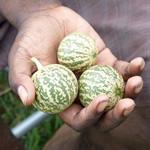Miriwoong Seasonal Calendar
21 February 2012
The Miriwoong Seasonal Calendar is an interactive representation of the traditional weather knowledge of the Miriwoong people. Using video, visuals and sound, the calendar was designed by the Mirima Language and Culture Centre and the Kimberley Land Council.
The Miriwoong Seasonal Calendar focuses on:
- preservation of traditional language and culture;
- language links with the environment;
- relationships between flora, fauna and climate; and
- native plants and animals as indicators of seasonal climate change.
"We have been learning about the seasons from past generations and are passing them on to our children. Now we can do this with the help of 21st century technology and share our knowledge with the wider community." Annette Chunama, Mirima Council Vice-chair.

Miriwoong Seasonal Calendar
Seasons and stages
The Miriwoong Seasonal Calendar has three seasons, broken down into eight stages.
| Seasons | Stages |
|---|---|
| Nyinggiyi-mageny Wet |
Barrawoodang December, January: Strong wind, thunder, lightning and big rain. |
| Jaloorr-mageny February, March: Rain (coinciding with monsoonal downpours). |
|
| Warnka-mageny Cold |
Genkaleng April, May: South winds start, introducing cold weather. |
| Werlthang June: Dew forms overnight and dries in the morning. |
|
| Manbilying July, August: Irregular cold weather rain (doesn't occur yearly). |
|
| Barndenyirriny Hot |
Boornbeng September: Country starts warming up. |
| Dilboong October: Country dries out and becomes brown and dusty. |
|
| Deroorr-mageny November: Thunder, heat and humidity, introducing the wet season. |
Developed for the Indigenous Weather Knowledge website
Launched on February 18, 2011 at the Bureau of Meteorology in Melbourne, the calendar was designed as an addition to the Bureau's Indigenous Weather Knowledge website.
"Developing the Miriwoong Seasonal Calendar has been an important and engaging project for Mirima Dawang Woorlab-gerring." David Newry and K.J. Olawsky, Mirima Language and Culture Centre.


Comment. Tell us what you think of this article.
Share. Tell others.